Fiarenana - Expanding Zahana's work
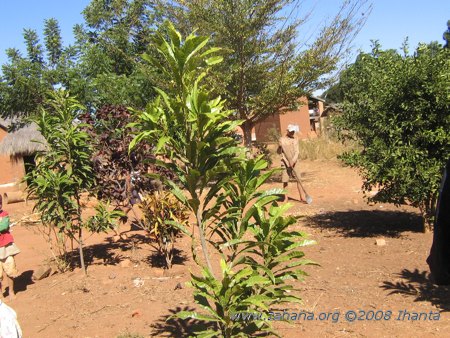 In May 2008 the village of Fiarenana*
sent an official delegation to Fiadanana to meet with Zahana during a site
visit. In this formal encounter they asked Zahana for assistance in their
village and invited Zahana to a community meeting to explore the possibilities
for cooperation. In Madagascar all major decisions in villages are discussed
on a community wide level and being formally invited is the best way to
work productively with a community. Zahana always planned to expand its approach of rural
transformation through participatory development beyond the pilot village
of Fiadanana. (For many events since 2008 please consult the links to the right)
In May 2008 the village of Fiarenana*
sent an official delegation to Fiadanana to meet with Zahana during a site
visit. In this formal encounter they asked Zahana for assistance in their
village and invited Zahana to a community meeting to explore the possibilities
for cooperation. In Madagascar all major decisions in villages are discussed
on a community wide level and being formally invited is the best way to
work productively with a community. Zahana always planned to expand its approach of rural
transformation through participatory development beyond the pilot village
of Fiadanana. (For many events since 2008 please consult the links to the right)
Neighboring villages witnessed the big improvements that, for example, clean water and a school brought to Fiadanana and approached Zahana for help as well. In the past requests from other villages were for a water system or a school, both a commitment that Zahana cannot presently afford with its limited resources and all volunteer board.
Fiarenana is very different from many of the surrounding villages. While in most villages trees are rare, Fiarenana has many trees, including fruit tress that have been planted intentionally to provide shade and fruits to eat. An additional benefit of the trees is that people do not have to walk far in search of firewood but can use branches. To see the pictures of Fiarenana please click here.
In June 2008, Zahana spent the day in Fiarenena and held a formal community meeting. The results of this meeting were very promising.
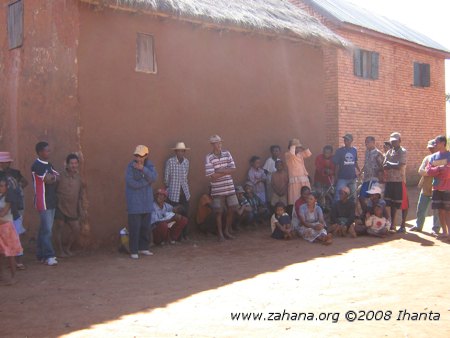
Community meeting in Fiarenana
The priorities they want to address are:
- Malaria prevention and access to malaria medication
- Revitalizing a currently defunct tree nursery
- Improving crops and crop diversification
- Getting access to safe drinking water, by improving their well system. Photos status quo ante click here. For photos of the newly built water system in 2009 click here
- A school or day care facility for the younger children.
Zahana has great hope that Fiarenana could become a model village that could teach others in the future. A great willingness to work on their own development goals makes this village ready for change and all they need is cooperation from Zahana for financial support and expertise to implement their goals.
Four examples:
Their willingness to go the extra mile (literally) can be seen in the fact that all children of school age go to school in neighboring villages, some of them walking for two hours each way.
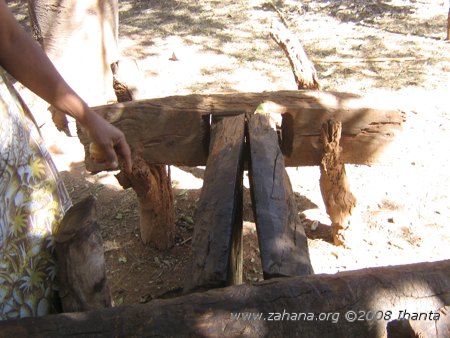 One
of the women in the village has designed her own oil press. For her cooking
oil needs she is growing the peanuts that she then can press to extract
the oil. Since cooking oil is one of the major needs for cash in villages,
building on her experience can be a major learning step for more economic
independence.
One
of the women in the village has designed her own oil press. For her cooking
oil needs she is growing the peanuts that she then can press to extract
the oil. Since cooking oil is one of the major needs for cash in villages,
building on her experience can be a major learning step for more economic
independence.
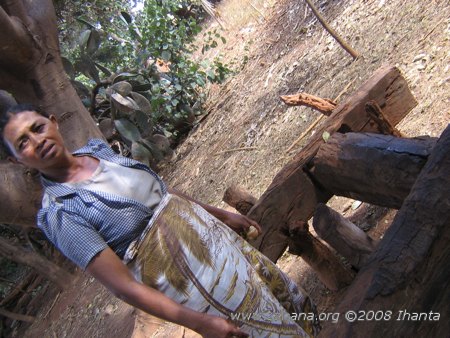
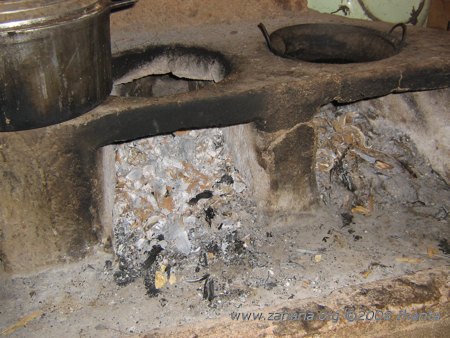 Some
of the villagers are already using their own design for an improved cookstove
that uses much less wood. With minor adaptations, such as a chimney
that takes smoke outside of the house, this can be implanted community
wide. One of Zahana’s ideas is to exchange the mosquito nets for
the commitment to built an improved cookstove in every house in the village.
Some
of the villagers are already using their own design for an improved cookstove
that uses much less wood. With minor adaptations, such as a chimney
that takes smoke outside of the house, this can be implanted community
wide. One of Zahana’s ideas is to exchange the mosquito nets for
the commitment to built an improved cookstove in every house in the village.
In years past Fiarenana had the support of a protestant charity to maintain a nursery. While the trained gardener is still living in the village the nursery did not make it after the funding of the charity ran out. Revitalizing the nursery, as a mico-credit enterprise that could provide seedlings for the entire region and including fruit production for the market, is something the community is ready to do. Since the gardener needs to spend time on the nursery instead of farming, some form of salary in the initial phase is needed to get the new seedlings into the ground.
Demographics:
With a population of only 282, 127 are older than 15 years of age. In rural Madagascar anybody over 15, who is able to work in the fields, is considered an adult. Of the remaining 155 ‘minors’ 76 and girls and 79 are boys. The average family has five to ten children. The village has a total of 38 houses with 75 beds and one church. The village already has 17 pit toilets.
The current water supply of Fiarenana in 2008:
Access to safe clean drinking water is the primary public health challenge. Everybody gets their water from wells that use groundwater. This groundwater, especially when it is too close to the houses, can be contaminated with pathogens. This is unfortunately the case, since most children suffer from diarrhea.
A communal well, some ten minutes walk is used by most. A major improvement is that the well is covered and protected from debris and animals, but getting to the water is still dangerous especially for the children.

Bending down to get to the water table with
the bucket
• Participatory Development: rebuilding the old well
Pictures/photos from FiarenanaThe
community building a school in Fiarenana
*It is unfortunate that for foreigners the words are very similar, although in Malagasy Fiadanana is “peace” and Fiarenana along the lines “getting up when you fell down”.










